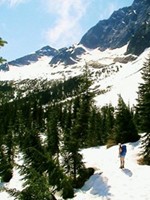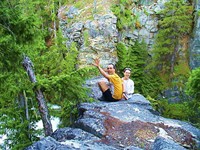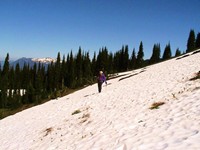Most trail journals are incredibly dull. They go something like this:
"July 6: Walked 23 miles today. I wish I had some pizza. My feet hurt. Saw a squirrel."
"July 7: Walked 21 miles today. I want ice cream. My knees ache. Saw a deer."
"July 8: I jumped off a cliff cuz I was so bored with myself."
I want to spare you the agony of reading such a monotonous drivel.
Therefore, I'll focus on the highlights of the first 10% of the trail, or 270 miles, instead of documenting every single day.
You may have already read the story of my first 70 miles, from Manning Park, Canada to Rainy Pass, Washington State.
Why the Canadian visa process sucks
The Canadian government makes it incredibly hard to get a visa. Indeed, Maiu Reismann, an Estonian who has a 10 year visa to America and has visited the US several times, had to jump through all kinds of hoops to get a visa to Canada. Why? Because Canadians have a hard time acknowledging this fact: most people think America is more interesting than Canada.
If you give a random person on this planet a chance to visit either America or Canada, most people will choose America over Canada. Canada may have colder weather, but America is cooler.
So the Canadian government should just make a simple rule: if you get a visa to America, you automatically get a visa to Canada. And Mexico might as well implement the same rule. After all, how many people will overstay their time in Canada when they could just go back to the USA?
Of course, if you don't get a visa to the USA, Canada is free to make foreigners give blood samples just so they can get a chance to visit Canada's frozen tundra.
Since Maiu couldn't get a visa quickly, she couldn't start the PCT in Canada, and she meet me at the first major US road crossing - Highway 20 at Rainy Pass. Venkat Bhamidipati, a great friend, offered to drive her there. This was an incredible act of trail magic: the drive from Seattle is almost four hours, one way.
300 miles of Washington snow
On a sunny morning at Rainy Pass we headed south to Stehekin. The first 30 miles of nearly flat terrain made for a soft introduction to the PCT and a way for me to recuperate from my 70 mile adventure. However, soon we ran into a big obstacle: Suiattle Pass. A Sobo section hiker, Woebegone, had warned us that Mt. Suiattle was buried in snow. He said it was so bad that he turned back and decided to go to Oregon and hike there instead.
Although I considered taking the alternate PCT route, which follows Agnes Creek and goes around Suiattle Pass, I've figured the official PCT can't be harder than the taller passes I overcame north of there. To get over Suiattle Pass we had to cross endless fields of deep snow, ford icy rivers, and bushwack through steep terrain when we got lost. Like I predicted, it was easier than the first 70 miles.
After Mt. Suiattle, we continued to encounter more snow than dry ground. Hundreds of snow-filled miles later we finally reached Snoqualimie Pass (near Seattle).
We hitchhiked from Snoqualimie in a Hummer H2. I would have liked to drive that beast on certain sections of the trail.
Maiu was happy to hitch out. She was going nuts and needed to thaw out.
- Will Maiu quit?
- Will Francis quit?
- Will the snow in Washington ever melt?
Find out in the next article.
Sponsor spotlight: MealPack
Many people ask me what I eat on the trail. Answer: at least 5,000 daily calories of mostly nutritious stuff.
Before the PCT I learned that MealPack won Backpacking Magazine's award for the best energy bar. I tried a bar and loved it because it's got:
- Over 400 calories per bar, twice the energy of most bars.
- All the essential amino acids, along with almost 40% of your daily protein requirement. - Low sugar (most bars are so sweet I get sick of them quickly).
- A low price.
- All natural, unlike most bars, which have hard to pronounce ingredients.
I am lucky that they sponsored this PCT journey. Check them out at www.mealpack.com.





